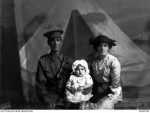MOFFAT, John
John Moffat was born in Glasgow, Scotland in 1885, but when he was six months old, his parents migrated to New Zealand. He was brought up in Dunedin and had three brothers, two of whom, Robert and William, also enlisted. William was also a casualty.
In 1915, John Moffat lived with his wife Emily and two baby daughters, Marjorie and Jean, at 545 Victoria Parade, East Melbourne. He was a labourer, aged 37. On 19 January, 1915, he enlisted at the Melbourne Town Hall. he was sent for training to Broadmeadows and then on to Holdsworthy.
It was at Holdsworthy Camp that the 31st Battalion was formed. Half of the recruits were from the Enoggera Camp, Queensland, and half, like John Moffat, had enlisted in Victoria. They sailed from Melbourne on HMAT Wandilla in November, disembarking at Suez on 7 December, 1915 to join up with the rest of the 5th Division. Here they undertook more training in camp at Serapeum and were engaged in defending the Suez Canal against Turkish forces. On 21 January, John Moffat was made Lance Corporal. On 22 January, he was admitted to hospital with pleurisy. He was discharged after two weeks, returning to camp, where he must have impressed, as he was promoted to Corporal.
On 16 June, the 31st Battalion left Alexandria to join the British Expeditionary Force in France, landing at Marseille on 23 June. Their first major battle in the front lines was at Fromelles, a disastrous conflict. The 31st Battalion suffered 572 casualties, almost half their strength. The adjutant's diary for that day reads 'very heavy casualties and men completely broken ... Estimated casualties 6oo of all ranks.'
John Moffat survived the battle unscathed, but was obviously badly shaken. Two days later, on 29 July, he was arrested and sent for Court Martial in that he was drunk on active service ' to the prejudice of good order in that ... he on the line of march became unfit for duty.' He was sentenced to 28 days' Field Duty, was reduced to ranks and suffered a loss of pay. The 31st returned to the fight in September, and took part in the battle of Polygon Wood on 26 September.
Other offences followed. On 24 November, 1916, he was absent from his billet and arrested ' riding a tram without permission', forfeiting one day's pay. On 21 November, he was sent to hospital and four days' later, scalded his feet. In spite of these signs that all was not well with him, he was returned to being Lance Corporal on 22 December and, a week later, to full Corporal.
In January, 1917, the 31st Battalion were moved to the front line at Trones Wood, near Bapaume. The adjutant's diary follows their movement.
31st Battalion Tuesday, January 16, Front Lines (Needle Dump)
1.30 Battalion marched out to Trones Wood to intermediate line, right Brigade front. 'B' Company remaining in A Trones Wood. Coy. commanders visited front line and saw various sectors. Relief complete at 6.15 pm.
31st Battalion Wednesday January 17, Front Lines (Needle Dump)
5 pm Battalion commenced to move up to Front Line Trench. A Company on right, B Company on Right Centre. C Company on Left Centre. D Company on left. Lewis Machine Gunners distributed along Battalion front.
31st Battalion Front Lines (Needle Dump) Thursday 18 January.
Battalion in front line. Shell fire is at (sic) desultory nature. Machine guns and snipers busy.
John Moffat died from a sniper's bullet on Thursday, 18 January. There were plenty of eye witnesses, five giving testimony ot the enquiry into his death. W. Alison, giving his statement in London on 25 June, 1917, remembered:
I saw him carried in dead. He was shot staright through the forehead and the bullet came out of his back. I believe he was stooping at the time. He was in No Man's Land shile on patrol. He was sure have been buried. He came, I think, from Melbourne, was medium height and over thirty years at least. He was very well liked by everyone, a good sort.
John Moffat is listed on the Roll of Honour and remembered on Panel 117 of the Commemorative Area of the Australian War Memorial at Canberra. He is buried at Bancourt British Cemetery, 1.4 miles east of Bapaume. His widow moved to Gertrude St., Fitzroy, and then on to George St., Fitzroy. She was given a war widow's pension, with extra for her two daughters. In 1918 she remarried and moved to Bexley, NSW.
National Archives of Australia, Service Record
Australian War Memorial, Roll of Honour, Red Cross files, Unit History 31st Battalion.
www.8thBrigade.ord.au/?tag=31stbattalion Australian Imperial Forces 8th Brigade, Adjutant's diary.

